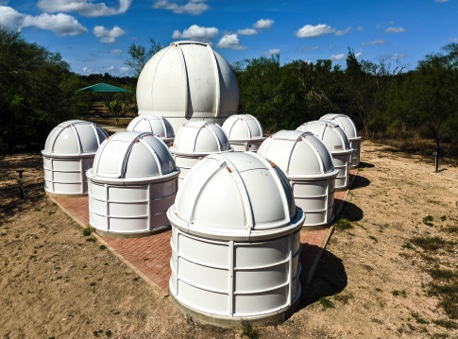Observational Astronomy
The material displayed in these pages is the result of a class in observational astronomy I taught with the invaluable assistance of Carlos Colazo and Raúl Melia. Carlos and Raúl are both amazing amateur astronomers. As a theoretical physicist who morphed into a mediocre but passionate astronomer I'm eternally indebted to their assistance and mentorship.
I put together this pages with the hope that they can help all the astronomy lovers from the Rio Grande Valley who want to observe at our Dr. Cristina Torres Memorial Observatory. They should provide enough background to get started with serious scientific observations of the night sky.
UTRGV, TSC and RGV HS students: please help us improving these pages pointing to omissions or mistakes. All suggestions are welcome.
Other Resources online
One of the best simple introductions to Astronomy in general is the Space book from Las Cumbres Observatory. It covers different topics in Astronomy from how to look at the sky to the life cycle of stars, from galaxies to exoplanets. The following is a link to the site:
https://lco.global/spacebook/
If you know of any other similar resources please provide us a link information so we can post it here.
The following are the lessons available in this tutorial.
Lesson 1
This lesson is essentially a quick introduction to all the basic concepts: conveyors of information, refraction, reflection, chemical elements spectra, optical telescopes, elementary basic optics, magnitude, photometry, star spectral classes, filters.
Lesson 1 this is a pdf version.
Lesson 1 this is a keynote (MacOSX) version.
Lesson 2
This is a very rough, quick and dirty summary of statistics and probability.
Lesson 3
The following is a tutorial on astronomical coordinates. It has been written by Carlos Colazo and Raul Melia. It is in Spanish. Help in translating it to English will be greatly appreciated.
Lesson 3 pdf file. The following is a Sun's motion demonstrator.
Lesson 4
This lesson is about CCDs, the digital cameras use by modern astronomers. Most of the material is based on the book: To Measure the Sky, An Introduction to Observational Astronomy, by Frederick Chromey, Cambridge P., Ch 7 and 8.
Lesson 4 a pdf with discussing how CCD works.
Lesson 4b this second part, also a pdf explains how photometry is performed using a CCD.
Lesson 5
The key concepts covered in this chapter are:
Angular distance
Main parameters in a telescope
Main parameters in a CCD
Plate scale
Space resolution
Seeing
Binning
Time resolution
Exposure time
Camera orientation
FOV and positioning
Stationing of the telescope mount
Lesson 5 - Spanish (material developed by Carlos Colazo).
Lesson 5 - English (a translation of the above material).
Lesson 6
This is a quick summary of Optics concepts.
Lesson 7
This lesson is an introduction to Astrometry.
From Scholarpedia (http://www.scholarpedia.org/article/Astrometry): "Astrometry is the science which deals with the positions and motions of celestial objects. Astrometry is now one of many fields of research within astronomy. Historically, astrometry was all that astronomy was about until about the 19th century".
The following page contains links to a theoretical introduction, tutorials and data files needed to perform the tutorials:
Lesson 8
This tutorial will let you check the accuracy of the astrometries performed in the previous lesson.
Lesson 9
This tutorial will let you improve the quality of your images for further processing.
Lesson 10
This tutorial will introduce to the technique of obtaining and processing light curves.
A tutorial
